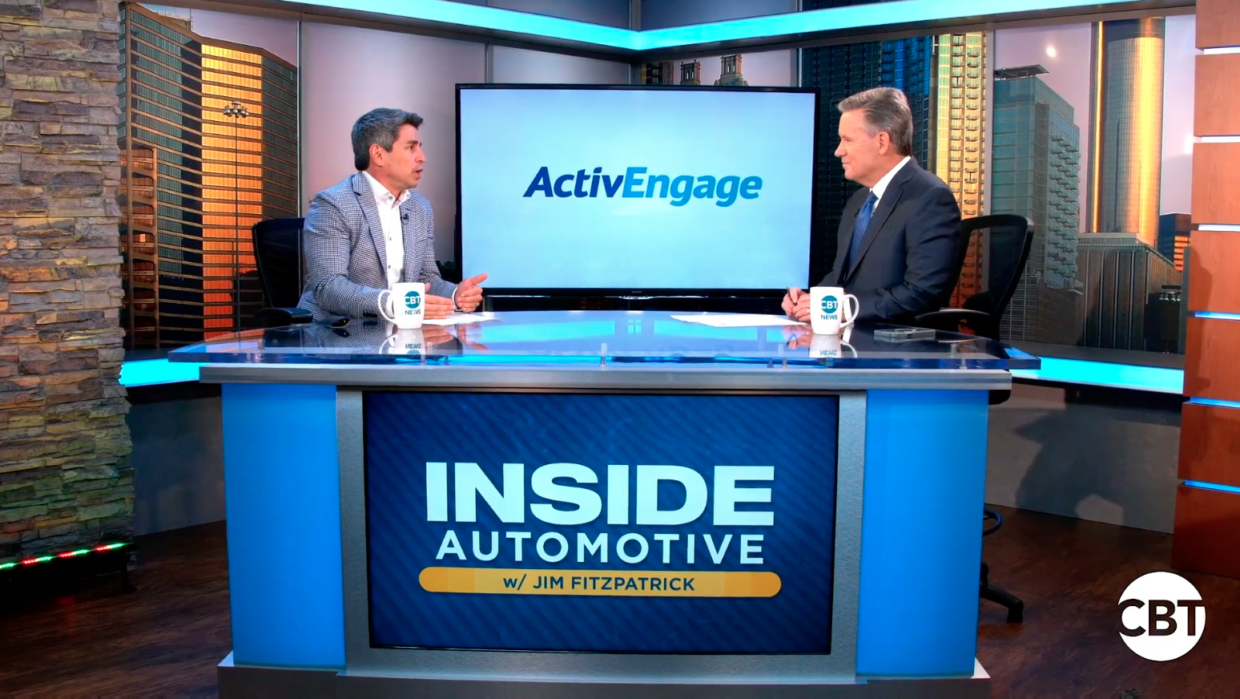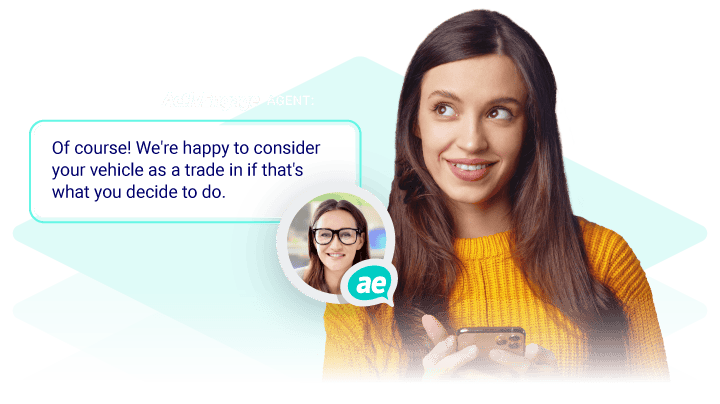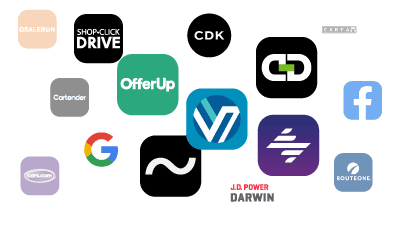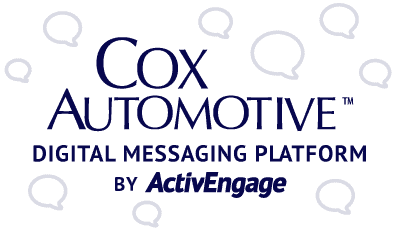Jim Fitzpatrick: As the industry moves further into a digital future, you need to be mindful of your digital experience. Joining us in the studio today is Ted Rubin, the Chief Executive Officer of ActivEngage, a people-powered web-based live chat and communication solutions provider to discuss the latest insights and trends into dealer to consumer conversations. Ted, thank you so much for joining us once again in the studio. We really appreciate it.
Ted Rubin: Yeah, thanks for having me. I love being here.
Jim Fitzpatrick: This is always a hot topic. I think we got a lot of emails last time you were in. You said, ask him this, ask him that, ask him this. Because this really is the future of the industry, right? I mean, this is where consumers want to be met, right? Early on, talk to us about that.
Ted Rubin: Yeah, I think that, you know, certainly online sales and digital transactions are kind of on the uptick and everybody’s seeing that and it’s been going that way for quite some time. And I think consumers are really starting to drive that interaction in a significant way now. They want this more customized, kind of hyper-personalized experience online and they want to be treated well there.
Ted Rubin: You know, 64% of consumers, according to one of the studies, you want to be able to interact with the dealers and other brands in the same way they interact with their family and friends and others that are around them. So they want to use the same utilities and they want to use the same functions to be able to do that. So I think that dealers, you know, are starting to recognize that and they’re starting to look more toward how can they interact with these customers and give them that kind of unified experience because the online marketplace is really where everybody’s kind of funneling in now and then they disperse from there.
And that’s been for a very long time, but they didn’t have an outlet, right? So they would go online, do the research and then pick up the phone or maybe send an email or something or go into the store. And now with digital retailing and with all the things that you can do conversationally, interactively with customers, you can accomplish so much more and customers want to take advantage of that.
Jim Fitzpatrick: They want that, right? I mean, I’m right now and in fact, I’m waiting for a few texts from vendors of mine.
I’m like, don’t call me. Don’t send me an email because I might not read the email, right? But I’m going to read my text message, right? Have you found that to be the case where everybody reads their text message?
Ted Rubin: Oh, yeah. I literally, you know, because I’m old, I left a voicemail for someone the other day and you know, they didn’t call me back.
Jim Fitzpatrick: What is a voicemail?
Ted Rubin: Exactly. Exactly. And so I never got a response. And, you know, a day later, I text them. I got an instantaneous response. Oh, I didn’t even, you know, I ignore the voicemail. That’s right. So, you know, that is what customers want.
That’s what I want, too. I mean, I like to interact in an efficient and quick way. Plus, you know, you can kind of interact with someone and they can look at it. Not doesn’t have to be the second, although a lot of people do and they can get back to you and interact on their schedule.
Jim Fitzpatrick: I recently called my sister and her voicemail. She’s a successful real estate broker. And she said, do not leave me a voicemail. I don’t listen to them. Please text me if on anything that you want to discuss. I’ll call you right back. Right. And at first, when I heard them, I was taken aback a little bit. I’m like, well, the nerve of her, you know,
Then I adopted that. And I’m like, that’s a great idea to let somebody know. Don’t leave me a voicemail. Right. You know, go ahead and text me. Feel comfortable enough to do that. Because I think at some point in time, it was kind of a personal, oh, did you text me? Do I know you well enough for that? Right. And now you want to lead with that.
Ted Rubin: Right. Consumers want to lead with that. Yeah. I think it’s just a facilitated process. Right. You have documentation of it. You can refer back to it, especially if there’s a lot of detail. I think for dealerships and for businesses, it’s a huge advantage, actually, for both the customer as well as the business, as well as the dealer, because it’s all right there. So if you want to put out a lot of detail, then you know that the customer has it in front of them. It’s detailed.
They can reference it. The customer can understand what it is, metabolize the information, and go back to it if they need to. And that way, there’s no cross wires. Things are explicit and clear. And that’s really what you want when you’re trying to do business.
Jim Fitzpatrick: Yeah. No question about it. Now, everybody in the world is talking about AI, right? ChatGPT, the whole deal. It’s very, very exciting.
It’s very, very scary for a lot of people, you know, that now even the founder of it is coming out going, wait a minute, this might need some guidance here. Right. But talk to us about the best ways dealers can leverage AI.
Ted Rubin: Yeah. I mean, we’ve spent a lot of effort, you know, looking at AI and integrating it and figuring out other ways that we can leverage what it is. The thing is that I think that people don’t temper is the fact that we’re still at the infancy of it. And it’s not really super effective at communication.
It’s barely, you know, it can write papers and things like that, but you can tell the difference. And it’s not always writing it in your voice. And it doesn’t have a tone. There’s no emotion with a computer. And so I think that a lot of people are putting it in front. So they’re putting it right in the front with the customer. And they’re saying, hey, you can talk to this first. And they’re waiting for a point of failure before they transfer over to an agent. And we think that that’s foolish.
You know, I mean, the best places to use AI are for the reporting, to help use it to identify the best way to have a conversation, to identify information while the conversation is going on and supply it to the agent so that they can communicate with it. But you really need an agent to kind of take some empathy to understand what’s going on. And the agent is going to motivate the customer to want to continue through the process where the computer doesn’t really understand emotions that well, it can kind of assess them.
But I mean, how would you teach something that is not a life form or even how would you teach your dog to have an emotion? So it’s hard to convey it. And I think we’re going to get there.
Jim Fitzpatrick: Last time we were together at NADA, part of the conversation included a VP from AutoNation. And she went on to say how this really is the future. That’s also why she picked Active Engage. So kudos to you for that. But when you get these big auto groups out there,
Lithium and AutoNation and others, you probably have some of the top ones, I’m sure, and they see that. You know, for the others in the industry, and you know who I’m talking about out there, go, oh, what are they doing? Because we need to be there. We need to do that, right? And I think that’s a pretty cool deal in the sense that it doesn’t cost the dealership a whole lot of money to win in this space, right?
Ted Rubin: No, it really doesn’t. It’s always surprising to me, you know, that this little amount of money that you’re spending to interact with your customers and to do it the most effectively, you know, it’s inconsequential relative to the amount of money that you’re going to make, especially if you do it really, really well. And so, you know, I think everybody should be doing it, and I think they should be super thoughtful about it. This is your representation to the customer, possibly the first time they talk to your dealership. It’s going to be through chat, through messaging, through text, through one of those services, and you want to make sure that you look the best, you know, when you’re doing that.
And so, you know, there’s a lot of dealers that we have, and a lot of the big groups, you know, they take it very seriously, and you’re seeing that across the board, you know, how they’re interacting. And I think that the entire dealer base should really pay attention to that. And I think they do, but I think they kind of sidestep because like, oh, it’s just chat. And there’s a pretty big difference, you know.
Jim Fitzpatrick: That’s like saying, oh, it’s just the showroom. It’s just the showroom, right. Who needs to pay attention to that? It’s just a car, you know, just pick any of them, they’re all the time. Just pick any of them. No, but you’re exactly right on that. So much so that I would challenge dealers today that are listening to me, shop your dealership and see what that experience is that your consumers have to go through. I know that when I was running dealerships, I didn’t do that kind of stuff. I’m like, ah, somebody’s handling it. We’re good. We hit our number. We got good gross profits coming in and good net profits. And I never shopped the store.
So when I had somebody at a cocktail party go, oh, my God, I shopped your dealership, Jim. And that was the worst experience in the world. You got to fix that. I’m like, what are you talking about? And then I realized it had been years since I had shopped my own stores to see what that was like as a consumer. You know what I mean? And I think you’ll be amazed as to what you find, right? Absolutely.
Ted Rubin: Yeah, I think it’s something that everybody should do on a fairly regular basis because everything changes, the content changes, the interaction, what people are asking, the way they ask questions. It changes pretty quickly. We see it all the time. So we’re used to keeping up with it. But it is a task to do it.
Jim Fitzpatrick: There’s no question about it. It’s much like listening to the phone calls that come into the dealership. You know, I didn’t listen to them that often. And every manager would lie to me and say, oh, no, we listen every day. We listen every day. How are the calls coming in? They’re all good. We take care. We’re doing a great job. Every now and then, somebody would say, you need to listen to the calls yourself, right? And I would listen to the calls and go, oh, my God, I can’t get to the third one. Turn this off. You know, with all the money we’re spending on advertising and this is how we’re handling the calls, if they’re answered at all in some cases. I think you’re going to find dealers, it’s the same with chat.
It’s the same with how a deal begins. Every deal today, and I’m painting with a broad brush. I feel this way. But every deal today starts online, right, to some degree.
Ted Rubin: I agree, yeah, absolutely.
Jim Fitzpatrick: And talk to us about that. I mean, if a dealer does not win that first initial connection, they’re not going to win the deal.
Ted Rubin: No, I don’t think they are. It’s really important that that first customer facing interaction is a superlative interaction, right? Customers want to interact that way and they want to feel like they’re being accommodated.
They want to feel like they’re empowered, which is why they’re on the Internet. Otherwise, they would just pick up the phone and call you or try to get to someone. But that’s always difficult.
Jim Fitzpatrick: I know it really is.
Ted Rubin: Yeah, and so you have to look really good to the customer when you’re doing this. So the more that you can bring to bear to offer services, to show that you’re knowledgeable, to show that you’re there to accommodate them and that you’re interactive and answering the questions that they’re asking.
Jim Fitzpatrick: That’s right.
Ted Rubin: And then even probing a little bit to make sure that you’ve gotten kind of a robust picture of what it is that you’re trying to accomplish. Because a lot of people fumble through, this is what I want. They don’t know or especially people who don’t know what they can afford or they don’t know what the credit’s like. Then they kind of fumble through it a little bit. And when you’re there to help them through that, then you’re done. You’re going to get the sale. And that’s really what it is that you’re trying to accomplish is build the relationship. From the first interaction from hello, you want to start building the relationship with the customer because that’s where it starts.
Jim Fitzpatrick: That’s right. I agree!
Ted Rubin: If you’re not starting at that point, well, then you’re just dismissing the customer and they’re going to feel like it.
Jim Fitzpatrick: That’s right. And to your point, if you’re using AI to do that initial and it’s not a human being, I think you’re missing a huge opportunity there.
Ted Rubin: Yeah, I really think you’re missing a giant opportunity there because that’s when they’re open and they’re there. That’s right. They’re waiting for your response. And when it comes back and it’s kind of agnostic, unemotional, unempathetic.
Jim Fitzpatrick: We’ve all had them. We’ve all had them. Right. Yeah. Then it just doesn’t make you feel good. And speed matters, right? Speed matters because I will text my wife or she’ll text me on an issue or whatever it might be. And I didn’t pick up my phone or I didn’t look at it or whatever and then she’ll text me again and go, are you mad at me? Because I didn’t answer the text in five minutes?! You know what I mean? But that’s the world we live in, isn’t it?
Ted Rubin: Well, five minutes is an incredibly long period of time.
Jim Fitzpatrick: That’s exactly right. You waited five minutes. That’s right.
Ted Rubin: You’re used to Google responding to ultra complex queries in a couple of seconds. That’s right.
Jim Fitzpatrick: That’s right.
Ted Rubin: So you expect that from everybody.
Jim Fitzpatrick: Like you’re waiting by the text, right? Yeah, that’s exactly it. But consumers are. When they do reach out to a dealership, they are waiting for that fast response, right?
Ted Rubin: No, they really are. And look, I think that to some extent, if AI was capable of doing better at building relationships, kind of having insight to the customer and things like that, then that is capable of responding. I think that in that speed, but I think that people can also do that. We respond extremely quickly to our customers, but we’re doing it with a tone that matches the customers, that shows the interest in what their agenda is. And it’s just all those little nuanced things that are just these interpersonal interactions.
Ted Rubin: And there is a voice that you can hear when you’re writing in text. It comes through. And just like when I hear about researchers or professors at schools, when they watch AI or ChatGPT write a paper, they’re like, well, it was really good paper. And it was a little hard to tell. But now they’re starting to look and they’re like, oh, there’s no emotion in it. It wasn’t written with that guy’s voice. It doesn’t really have a voice. That’s right. It’s just the data. And customers, they don’t want that. They’re going to know the difference.
Ted Rubin: And they want to feel embraced.
Jim Fitzpatrick: That’s right. It makes a big difference, too, when you’re shopping for a large ticket, specifically a car in this case. And you text somebody or it’ll be a drop down or whatever case might be on a website. And the individual comes back and says, I’m Tom Johnson. And by the way, if you want to take this offline, here’s my cell number. You want to stay online. I’m happy to help you in any way. Right away. I know there’s a Tom Johnson with a phone number.
So if I do want to jump on, in some cases, I do that. I’m like, yeah, you know what? I’ll call this guy, you know?
Ted Rubin: Yeah, we transition a lot of chats, you know, to someone at the dealership that’s expecting the phone call that is right there or if the dealer themselves are handling the conversations themselves. You know, we can transition, you know, directly from us and we can transition so that the chat can go to the representative at the store. We even have, you know, a new piece now. We came out with a couple of things. Video has been this really big thing.
Ted Rubin: And so we came out with bi-directional video and it doesn’t have to be so the customer doesn’t have to be seen. It’s their choice if they want to be. But we can start, you know, most of this stuff, like you said earlier, starts online and so you start interacting with the customer and from that first interaction, I think most dealers would be surprised how many people migrate into the DR from there. You know, so there’s assistance for sure when you’re in DR, when you’re talking to someone, they can help you get it through it. But I think there’s so many more people that move into the digital retailing tool that you’re using when they start there because you’re not going,
Ted Rubin: hey, are you ready to go to digital retailing? Are you okay for that now?. That’s not what’s happening. You know, you’re just talking to them and asking questions and saying, do you want to take another half a step, another baby step? And as they say yes, then you can just start doing it. And before you know it, you’ve pulled their credit, you’ve got their information, you know that they’ve already, yeah, all that’s already done. They’re in the middle of the process now. And they’re much more committed to the sale at your store by doing that.
Jim Fitzpatrick: That’s right! Hey, tell us a little bit about this latest announcement of the Cox Automotive, a phenomenal company. I can’t say enough good things about them. So talk to us about that.
Ted Rubin: Yeah, they’re a phenomenal partner for us and they push us and kind of drive us, you know, to do all kinds of interesting and different things. And we’re always looking to do new and different things that can really give the consumer, you know, much more power to kind of get through, right? To get through everything. So they, you may have seen it now, they asked us for, you know, this bi-directional video that we just started talking about. And we kind of compounded that with the MyDrive piece where we can show like walk-arounds on the car and we can show test drives and things like that.
Ted Rubin: And it’s just, you know, video has a significant impact on the consumer’s attention and they stay engaged with it for a longer period of time. And, you know, they really are looking to be able to drive the experience with the consumer where they can get all the way through the end.
Ted Rubin: And the breakage points in most and many of the digital retailing platforms is that, you know, they have trouble getting past the financing part. And there’s other areas where those breakage and they want to have, you know, they’re not asking us, you know, to see the customer, but they said, you know, can you give us visibility so that, not so that we can see the customer, but so the customer can see us and, you know, we can show them things, we can show them things off the desk, we can show them videos, we can interact with them.
And that way the consumer, again, you know, they can have more trust in the process because they feel like you’re a live person, you’re not a computer, and they don’t feel like they’re navigating this very complicated situation on their own. And so they kind of gave us that problem and, you know, we looked to solve that problem for it. We did it in a really successful way. And so they’re super happy. You probably see them. They’ve run ads about it now on television. Yeah, they show how you can interact with consumers.
Jim Fitzpatrick: That is so cool. Congratulations on that. Yeah, we really appreciate it. They are such great partners. They’re great partners of ours as well. And so what else is new? What are we going to be seeing coming out of your camp at Active Engage and as we get into the second half of it?
Ted Rubin: Oh my God, there’s so many things that are in the pipeline.
Jim Fitzpatrick: It’s a loaded question, right?
Ted Rubin: A lot of it’s kind of… Yeah, you don’t want to announce it yet. I mean, these things that we just, you know, the My Drive piece came out, I think, just, you know, maybe the last time that we talked.
Jim Fitzpatrick: And is that available nationwide for all dealers as well?
Ted Rubin: That is available nationwide for all the dealers. We signed an agreement with Roadster and we’re exclusive with them, and it’ll be coming up soon.
Jim Fitzpatrick: That’s great.
Ted Rubin: Obviously, we have most of the digital retailing platforms that don’t have their own messaging platform. So, you know, we’re interactive with Darwin. We’re interactive with the Cox Digital Retailing Platform, Roadster, obviously, and a myriad of different ones that are out there.
Jim Fitzpatrick: So you’ve been extremely busy. We’re kind of expanding Cox Automotive and AutoNation and Darwin. And I mean, it’s just so many out there. You’ve made some huge inroads and waves out there.
Ted Rubin: Well, I think that, you know, they’re seeing the same thing. They want to get more people into the DR. And so we want to be facilitating that piece. And I think that we get to see more of it, you know, because we just were across all these different brands and we have this interactivity with a lot of these different digital retailers and big website providers. So we just see more action. And so we have more types of conversations. We have many, many more conversations, you know, than anybody else does.
Ted Rubin: So the detail of that, you know, we can help a lot of these guys kind of understand what their customers are doing, how they get involved, you know, what the conversations are.
Jim Fitzpatrick: So in a lot of cases, your discussions with your prospective dealers that you might be onboarding are just also best practices. Yeah, here’s what so-and-so is doing. Here’s what other companies out there have found to be successful, especially for those smaller dealers that might be, you know, two, three franchises strong, which make up the majority of the dealers out there that don’t have, you know, that huge team that maybe an AutoNation or a Lithia or Asbury has, right? So they’re looking to people like you to say, will you tell us what’s working best?
Ted Rubin: Yeah, we can give you tons of efficiency. And we’re just seeing, you know, so much more because of just the breadth of what it is. Plus all that data is in the system. And so that’s how we’re using the AI, right? So we’re using it to be able to go in, mine the system, look at what all this data is, kind of metabolize what’s there and then come back and train our people. You know, this is the way conversations are going this week, you know, or just part of this week. And, you know, you need to be aware of these kind of questions. And this is how you would answer them. And this is where customers break off. And this is what keeps them engaged. This is what they like to hear.
This is, you know, these are the valuable points that you need to bring to bear. And so, you know, we have the ability to recommend things as well to the dealers and everybody, even the digital retailers that we interact with, you know, each has a niche and each has an advantage.
Jim Fitzpatrick: Right, right. That’s fantastic. And I’m not going to mention it because we don’t need to get into pricing, but I know what you charge for dealerships and dealers are listening. If you don’t call Ted after this conversation, shame on you, not shame on Ted. So this is a great opportunity. These are the kind of solutions that we want to be bringing you at CBT News because this is the world that we live in.
Jim Fitzpatrick: Shop your dealership today if you don’t believe me. If you don’t like what you see and what you’re experiencing, give Ted a call because I think you’re going to find you’re going to like his solution. He’s been doing it for a long time. The largest auto groups in the country are with Ted and some of the biggest vendor partners including Cox Automotive now and others are with Ted as well and it’s ActivEngage, of course.
Jim Fitzpatrick: So give them a try. You got nothing to lose, you know, benchmark a little bit. Give Ted a call and say, hey, here’s where we currently are. Where can you take us? I think you’ll be very surprised. You’ll also be surprised at his prices. So Ted, thank you so much for stopping by the dealership. Here I am in the dealership mode, right? We’re still at the dealership. You’re always at the dealership when you’re in the car business. So but thank you for stopping by the studio. I very much appreciate it and best of luck to you.
Ted Rubin: I look forward to our next time together. Thanks for having me. I love being here.
Jim Fitzpatrick: Great. Thanks for watching Inside Automotive with Jim Fitzpatrick. Delivering the news dealers count on for 10 years. Subscribe today and join thousands of other automotive professionals. CBT News. 10 years strong.








